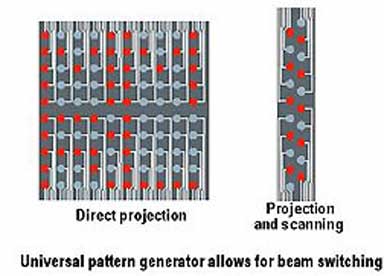APPLICATION OF TECHNOLOGY:
- Lithography, ion implantation/doping, magnetic storage
ADVANTAGES:
- Can generate multiple patterns with a single mask
- Produces feature sizes of 50 nm or less
- Beam reduction potential up to a factor of 50x
- Eliminates the first stage of the conventional IPL system
- Offers potentially higher throughputs
- No stencil mask:
- Minimizes the need for pattern mask development
- Minimizes the need for defect detection and correction
- Eliminates multiple pattern processing stations

ABSTRACT: The universal mask or pattern generator provides an ion projection lithography (IPL) system that is electronically switchable to generate a variety of different mask patterns using a single apparatus. Developed at Berkeley Lab with the support of the Defense Advanced Research Projects Agency (DARPA), the pattern generator consists of an array of microapertures on the plasma electrode and the extraction electrode which are separated by ~ 5 µm layer of insulating material. Individual beamlets can be switched on and off to form a lithographic pattern by biasing the extraction electrode at each microaperture with respect to the plasma electrode.
Eliminating the stencil mask from the lithographic process via the Berkeley Lab universal pattern generator would potentially result in significant cost savings because mask development, and defect detection and correction would be minimized. The use of an electronically controlled pattern promises to enable high throughput and rapid implementation of new designs, since multiple mask steps are performed by the same machine.
Preliminary calculations indicate that throughput of 30 wafers (300 mm) per hour or higher could be achieved at current density of 100 µA/cm2 (at the wafer plane). Currently, 160 nm features at 566 nm pitch on polymethyl methacrylate (PMMA) have been achieved with a 10x demagnification column design.
Ka-Ngo Leung and William Barletta have also developed an efficient multiplex addressing system for producing patterns using the universal pattern generator. This invention employs an electronic grid to control the switching of each beamlet so that every beam hole in the plasma electrode does not have to be individually wired, greatly reducing the number of wiring connections.
STATUS: U.S. Patent #6,888,146. Available for licensing
REFERENCE NUMBER: IB-1387, IB-1579
SEE THESE OTHER BERKELEY LAB TECHNOLOGIES IN THIS FIELD: